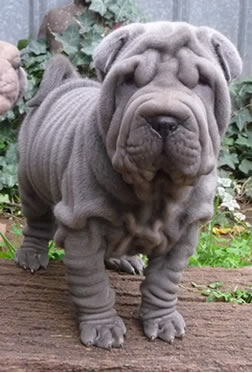COUNTRY: China
WEIGHT: 45-55 pounds
HEIGHT: 18-20 inches
COAT: Short, bristly, stand-off outer coat; very short, called horse coat; slightly longer, called brush coat; no undercoat
COLOR: Fawn, cream, red, black or chocolate
OTHER NAMES: Chinese Fighting Dog
REGISTRY: FCI, AKC, UKC, TKC
GROUP: Northern
Although the breed gained recognition as a fighting breed with obvious mastiff characteristics, the Shar-Pei also attributes its background to the Nordic genes and perhaps others. Chow-type dogs may have been crossed with Western mastiffs brought in on the early trade routes. The pariah may have even added a drop or two of its blood.
Whatever his background, the Shar-Pei has existed for centuries in the southern provinces near the South China Sea, with Dah Let, Kwan- tung Province given as its source. The breed aided the peasants through hunting, herding and protection—and provided them entertainment through dog fighting.
The loose skin enabled the dog to turn on its opponent even when grasped firmly in his enemy’s teeth. He was said to be capable of turning around in his own skin. The tiny ears and deep-set eyes were other qualities much desired to prevent injury. His short, bristly coat was distasteful in an opponent’s mouth.
While the Chow Chow was gaining popularity abroad, the Shar-Pei breed was being decimated at home in China. They finally disappeared in mainland China, and only a few remained in Hong Kong. It was during that time a clever owner, Matgo Law, became concerned that his beloved breed might disappear entirely. He wrote to an all-breed dog magazine, beseeching Americans to become involved with the plight of the Shar-Pei. His impassioned plea and the accompanying photos brought immediate response from the Western Hemisphere.
When a few specimens were brought to the United States in the 1970s, they were considered the rarest dog in the world. Their unusual features swiftly made them the darling of the talk shows which, in turn, ignited the excitement among those people craving the unique and eclectic. Shar-Pei numbers are increasing rapidly and they have been accepted for registration with the UKC and the AKC’s Miscellaneous Class.
Except for even more skin, the very tiny drop ear (like no other breed of dog), and the thicker padding of the muzzle, they are much like a very smooth-haired Chow. They also have the black mouth pigment and tongue, making the relationship obvious. The tail may be carried in a tight curl, loose curl or arched.
Breeders describe the head as being “reminiscent of a hippopotamus,” with a broad muzzle padded with flesh and described as a meat-mouth. The horse coat is preferred over the slightly longer brush coat, solid colors chosen over “flowered” (spotted) and solid black tongues chosen over flowered ones.
Shar Pei pups are cute and tempting, but there is perhaps none more fascinating than a baby Shar-Pei clad in skin many sizes too large for him and definitely not permanent-pressed. Prospective
buyers must be aware of the breed’s idiosyncra-cies and be prepared to deal with them. The skin requires as much attention as a heavy-coated dog, since the wrinkles make them prone to skin disease. Eye problems can also result, and some breeders have the abundant eye skin “tacked” by the veterinarian at three or four weeks until about 8-10 weeks of age. Adults grow into their over-sized coat and wrinkles often appear only on the face and shoulders when mature.
Their mastiff heritage contributed dominant temperaments, and they may pick fights among their housemates. Their strong personalities require firm training and socialization. They want to be with their people, and their early house-breaking habits assure acceptance in the home. A kennel existence is torture for them.
